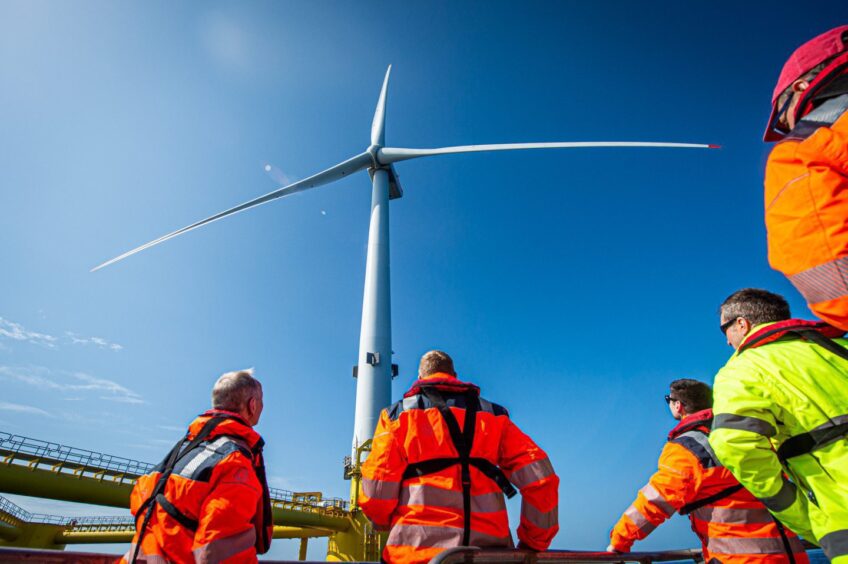
As the UK moves to decarbonise its energy supply by ramping up renewable energy innovation, we need to see a concerted effort to make good on research and development in our drive to further commercialise the sector.
A recent report carried out by the Offshore Wind Growth Partnership (OWGP) stated that the entire UK offshore wind market, combined with the global export market of expected offshore wind projects, could represent an economic opportunity of more than £500 billion for the UK by 2040.
The OWGP report shone a spotlight specifically on floating offshore wind, uncovering the £55 billion potential opportunity for a technology that is ripe for rapid expansion with the right investment.
Floating offshore wind, or FLOW, offers the chance to install projects in the deepest of waters, where high wind strengths are the most productive. The result is an abundant opportunity to generate clean energy, with exceptional potential for boosting a home-grown supply chain comprising everything from design and fabrication, mooring and anchoring, to assembly and installation.
The UK is currently home to the world’s largest deployment of offshore wind, with fixed turbines occupying large swathes of our coastlines. Floating offshore wind turbines have the potential to boost the UK’s renewable energy capacity even further, and the UK Government aims to deploy 5GW of floating offshore wind capacity by 2030 as part of their growth strategy.
Scotland has the potential to be a global leader in offshore wind, accounting for an offshore wind pipeline of more than 36GW, including 22.5GW of FLOW. In fact, Scotland’s FLOW pipeline is in the region of 25% of the total of planned works worldwide, cementing the country’s position as an offshore powerhouse on a global scale.
Across the UK we already have strong energy expertise stemming from decades of oil and gas capability that is perfectly suited to an offshore wind transition in general, and FLOW in particular. At the heart of this energy background, of course, sits Aberdeen as the HQ for energy exploration and subsea expertise in the UK.
Aberdeen: the FLOW powerhouse?
A report commissioned by the Floating Offshore Wind Taskforce called for up to 11 ports around the UK to be converted into industrial hubs to meet the sector’s future needs at a cost of £4 billion.
Aberdeen is one such port and lies at the heart of this concerted push towards large-scale offshore wind. With its extensive experience in the oil and gas sector, the city is perfectly placed to grasp the FLOW opportunity with both hands, helping to make forecasted projects a reality.
With more than 15 years’ experience in the offshore oil and gas sector, I transitioned into the renewable energy space, including a spell at Siemens Gamesa working on operations and maintenance contracts globally.
In my current role as Head of Business Development within the Offshore Renewable Energy (ORE) Catapult, I put my extensive oil and gas experience to work. By nurturing long-standing working relationships with offshore wind farm developers, their supply chains, government departments and various agencies, I work collaboratively with the wider energy industry, which is designing and delivering collaborative projects and commercial services.
One such industry stalwart is the Port of Aberdeen. The city’s harbour is already vital to the renewable energy supply chain as it connects integral land-based and marine activities needed to bring offshore wind projects to life.
Recently bolstered by the completion of the £420 million South Harbour expansion, Aberdeen’s existing infrastructure is home to the manufacture of the turbine components, cables, mooring systems, substations and substructures already used for fixed wind, and oil and gas projects.
Significant investment in further infrastructure close to the Port of Aberdeen, including specialist manufacturing, storage, outfitting, and maintenance facilities, will help to create a more robust, local supply chain. Ultimately, this will enable innovations in FLOW – the UK’s next frontier of renewable energy, with huge growth potential. Our Floating Offshore Wind Centre of Excellence and soon-to-open Floating Offshore Wind Innovation Centre (FLOWIC) are leading the way in research, exploration and best practice. FLOWIC is strategically located next to the new South Harbour within Aberdeen City Council’s Energy Transition Zone (ETZ) – an initiative expected to directly support 2,500 green jobs by 2030, alongside a further 10,000 transition-related jobs.
This bespoke facility, delivered in partnership with ETZ, will offer controlled testing and development that provide data-driven insights to support the wider industry identify and overcome the barriers to FLOW deployment.
During the invaluable research and development phase of any enterprise, businesses are naturally wary of the significant cash-flow risks associated with innovation. If we are to see Aberdeen realise its vision as a hub for the development of FLOW on an industrial scale, then we need to continue reducing costs, and crucially, we need to ensure that we create the attractive investment opportunities to unleash the technology’s full potential.
We all want to see the stars align so that Aberdeen can embrace the FLOW opportunity with both hands. The port city is situated in a prime opportunity area, but it must broaden and deepen its FLOW capability. However, an injection of large manufacturing investment would generate value for the sector on an individual basis, and building value-added supply chain clusters must be the priority for the sector.
For example, Aberdeen excels at the subsea expertise needed to bring forward large-scale FLOW activity. Cable manufacturing for fixed wind is done locally, and these components are vital for floating offshore wind projects too. However, current testing of these cables is outsourced across the world, as far as California, at significant cost and time. Coordinating investment in testing facilities in Aberdeen will strengthen our end-to-end capabilities, creating a value chain cluster that can be leveraged to give the UK a competitive edge on the global stage.
Currently, many stakeholders – government, developers and the supply chain – are standing in a circle facing each other, expecting other parties to take the uncertain first steps into the relatively unknown.
The appetite for FLOW is clearly there – and Aberdeen is well-positioned to play a central role in the offshore wind revolution. The city has a highly skilled workforce with invaluable knowledge from oil and gas that can transition seamlessly into FLOW with the right impetus and investment. Whether it’s better collaboration, sharing ideas, or addressing the economic, technological and skills challenges, industry and government in all its forms need to do something more.
We’re getting there, however it’s time to step into the circle, be more proactive, and realise Aberdeen’s vision to be a floating offshore wind powerhouse.
Recommended for you

 © Supplied by ORE Catapult
© Supplied by ORE Catapult © Supplied by Port of Aberdeen
© Supplied by Port of Aberdeen